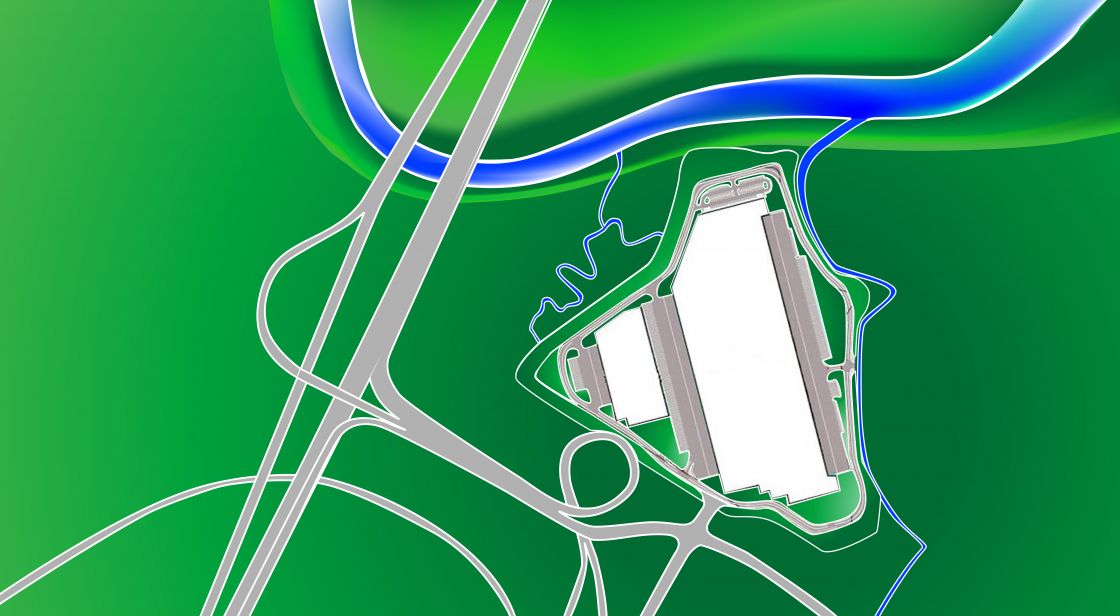Sustainable design and development are here to stay. As professionals in commercial real estate, we have the unique ability to take sustainable practices beyond building material selection and mechanical systems, which typically comprise just a fraction of our project scopes. One successful, sustainable commercial or industrial project can change entire environmental systems, economies and communities for the better.
With research and thoughtful planning, we can build projects that become the economic engines that drive into reality smart growth principles, such as anti-sprawl, open land preservation, and community building. We do this by treating distribution centers first and foremost as points in the market supply chain, and second as buildings. Subsequently, location is everything.
End users demand proximity to ports, highways, intermodal facilities, and a skilled labor source, particularly as transportation and fuel costs continue to rise. In our region, any remaining land meeting the criteria comes with great obstacles. Sites are overrun, overbuilt, abandoned, contaminated, you name it. The result is underutilized, often hazardous land you can’t drive by fast enough.
In 2004, the Port Authority of New York & New Jersey and the New Jersey Economic Development Authority recognized the need to improve brownfield and underutilized sites in the Port District, land within a 25-mile radius of the Statue of Liberty, and created the Portfields Initiative to encourage developers, owners and end users to restore these sites into productive commercial uses.
The New York and New Jersey ports are among the busiest ports worldwide. With trucks handling nearly 85 percent of their cargo, the location of distribution centers has an enormous impact on their marketability and sustainability. To demonstrate its significance, we have calculated that reducing trucking distance by 55 miles saves enough energy to power a 100,000 sf distribution center serviced daily by 20 trucks in one work year (260 days). In economic terms, the savings is even more dramatic. Assuming average fuel values from the Energy Information Administration of $4.91 per gallon of diesel, $0.0918 per kWh, and $11.76 per 1,000 cf for natural gas, we calculate a 15 mile reduction in trucking distance will generate enough savings in fuel to power the entire warehouse in one work year.
Beyond economics, these projects have tremendous sustainable implications. They physically clean up land that often contains underutilized construction sites or waste landfills. Landfills are capped, wetlands restored, and brownfields transformed into usable, productive land. Site redevelopment near urban centers provides employment opportunities, reduces sprawl and traffic congestion, creates ratables, takes advantage of older industrial infrastructure, and may preserve greenfields facing development. And that’s in addition to any sustainable benefits the building may bring.
Though these projects may sound optimistic, they’re happening now. In Carteret, N.J., KSS Architects worked with Panattoni and PA Associates to create iPort 12, a designated portfield site. After several years of collaboration through the planning and permitting processes, the project team achieved a victory for the township and environment. In nine months, the team closed three abandoned municipal landfills, installed a leachate collection system, and restored 15 acres of natural wetlands. The 113-acre site now has a 1.2 million sf Class A industrial distribution center that will provide ratables and jobs to the people of Carteret.
In Jersey City, N.J., design is underway for AMB Property Corporation’s Pulaski Distribution Center which, when complete, will revive the city’s industrial heritage by closing a landfill, providing jobs, and restoring public access to the waterfront. Additionally, we are designing the 900,000 sf building to accommodate roof-mounted solar panels, which may one day supply electricity to its tenants and the surrounding community.
In our industry, our greatest opportunities lie outside building walls. By looking at the overall supply chain, we can realize what immediate and long-term benefits are possible. If we continue to demonstrate the viability of turning brownfields into ratables, then public agencies and members of our industry will continue to support urban redevelopment and environmental remediation through investments, incentive programs and smart land use policies. As more end users factor sustainability, the cost of fuel, and the value of port adjacencies in their selection processes, our efforts and investments will prove worthwhile.

